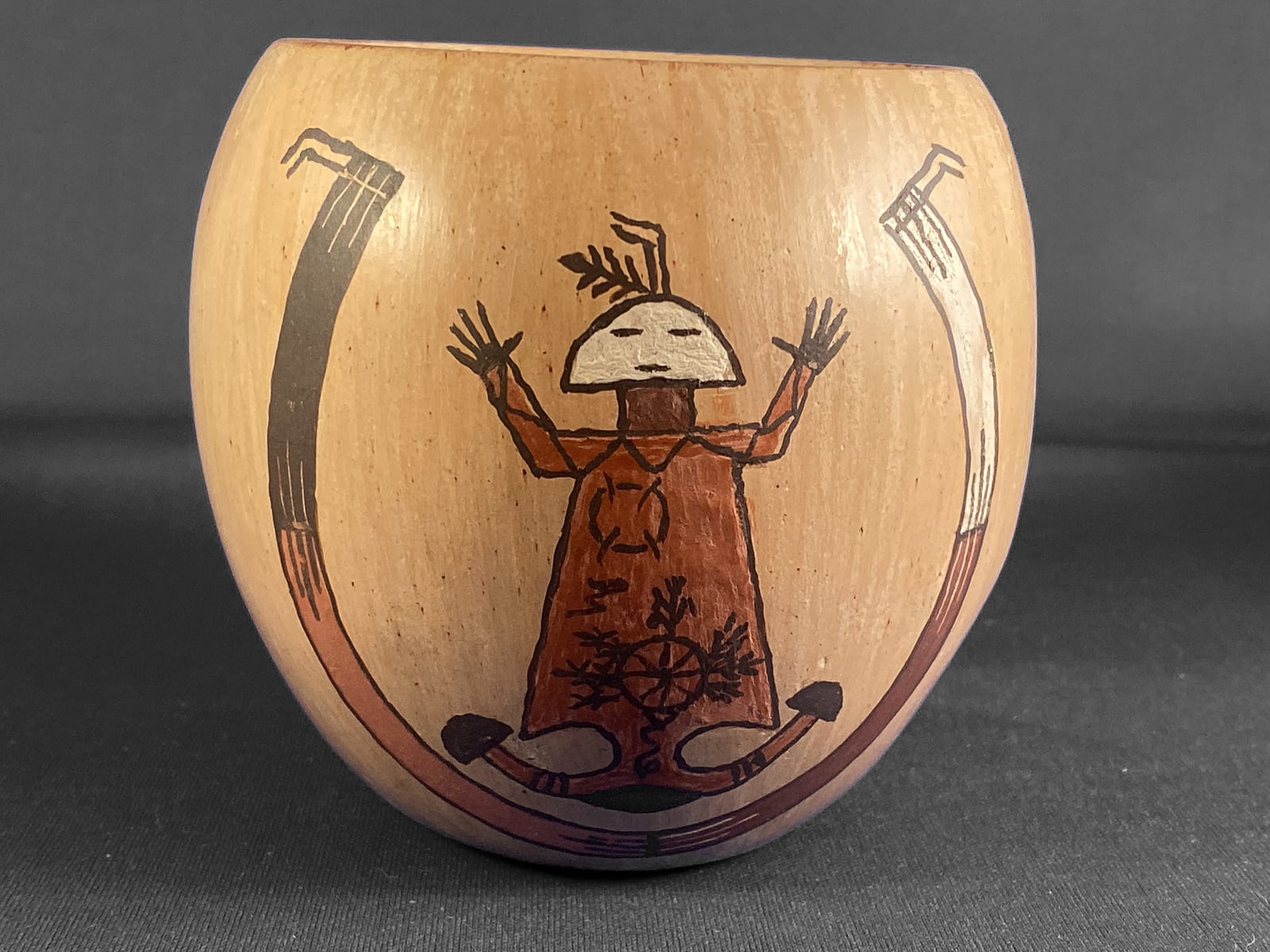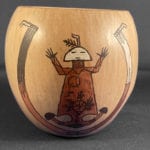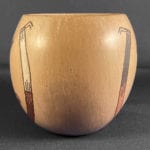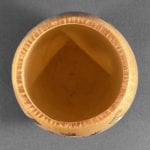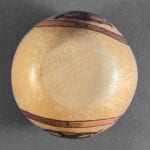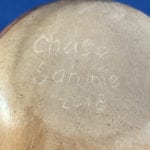This is a well-formed vase with unusually thick walls and is thus unexpectedly heavy for its size. It seems to have been vertically polished with a smooth stone. This is more difficult than the usual random stone polishing, but gives the finished pot a subtle, attractive finish. The pot was outdoor-fired, but is without blushing.
The thick edge of the pot is painted with dozens of thin red lines.
Mother Earth has a tan body surmounted by a half-circle face painted white. A feather and a plant emerge from the top of her head. Black hands are raised in blessing. Her body display symbols of uncertain meaning. Corn and squash plants emerge from a central wheel (Mother Earth?), likely indicating fecundity. Her lower extremities are “U” shaped with black half circles representing feet.
On three sides she is surrounded by a four color U-shaped arch. Navajo sacred colors are generally listed as 1) Black (north), 2) White (east), 3) Blue (south) and 4) Yellow (west). Here black and white colors terminate the arch, but the middle colors are red and tan. Like staples, three parallel lines connect the boundaries between the colors, drawn back in one segment and white in the next. The ends of the arch are finished with two parallel lines bent at the ends.
The hands, arms, torso and legs of Father Sky are painted midnight black, his head a white half circle and feet yellow half circles. Here too a feather and plant grace the top of his head. The iconography of his body is appropriately celestial: a large moon and star, smaller stars, an enigmatic zig-zag element and an outlined cross. His body is surrounded by the same four-color arch as seen around the Mother earth image.
These sacred beings are central to Navajo culture and the belief structure behind Mother Earth and Father sky is complex:
Together the two beings represent “a consumption of perfection, power, and benefaction (because they represent) the entirity of the universe, standing as a visual embodiment of our relationship to all that is…(T)he depiction of the Place of Emergence on the body of Mother Earth recalls the Emergence of the Earth Surface People (humans), and the depiction of each constellation on the body of Father Sky evokes the…story of stellar creation…(T)he depiction of the night sky represents the heavens, which are located above the earth’s surface…
(Together the two figures) represent female and male, the most fundamental of all bianary pairs: the female Mother Earth (sa’a naghai) and the male Father Sky (bik’e hozho), who together represent the entirety of the universe…(It is explained that together these are the most sacred images because) we walk everyday on our Mother Earth, under our Father Sky (thus together they are) a visual embodiment of humanity’s place within the cosmos, an expression of oneness with all that is….(H)umans have their existance within nature, as part of the intricate and infinite web of creation…(Y)ou are a child of both of them…(and together) they help you focus inward upon the most basic of Navajo principles — reciprocity based upon the interrelated totality that is the universe…
People must act responsibility, treating the creatures of the earth and the entities of the sky with the same respect they would accord their own parents, and in turn the beings of earth and sky will respond by blessing people with all the good things of life, as parents would provide for their beloved children…(This is) the right way of thinking and acting”
—-Provided by Twin Peaks Trading Post, Bluff, Utah
The pot is scratched signed on the bottom “Chase Sahme 2018.” Chase is the grandson of Andrew, Sr. and Ida Shamie. Andrew Sr. is one of the sons of Priscilla Sahmie and thus related to Nampeyo through Annie. Their son, Andrew, Jr. is Chase’s father. Ida is Navajo and produces pots with iconography identical to pot 2018-11. Clearly grandmother Ida is teaching her grandson to pot. For a tile by Ida, see 2019-15.

